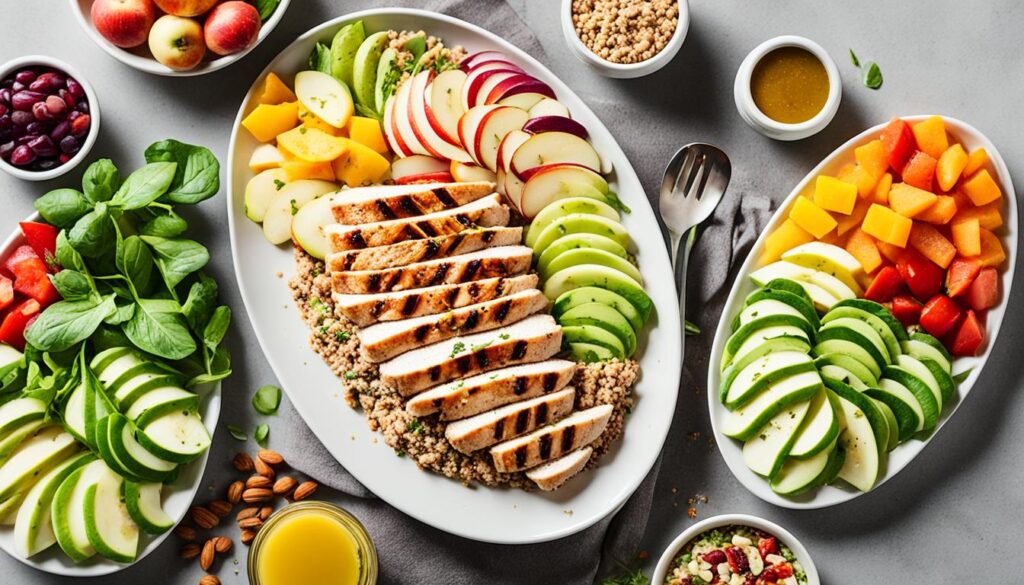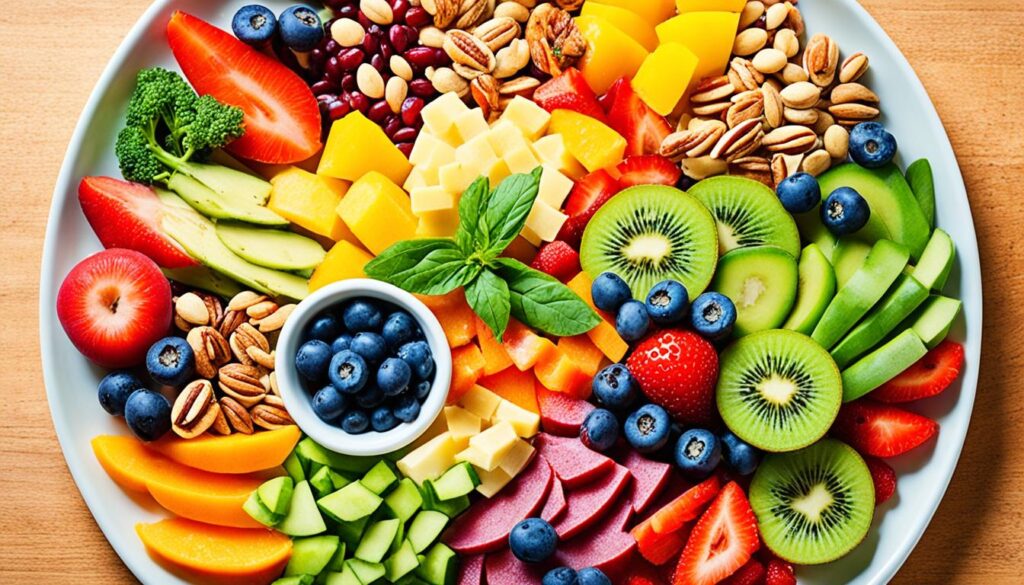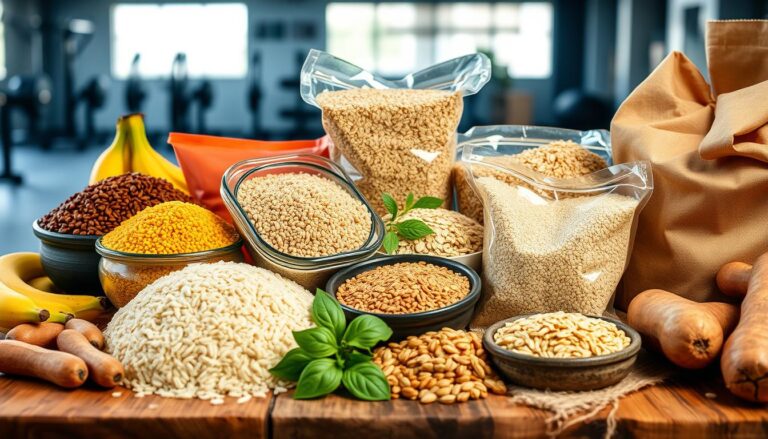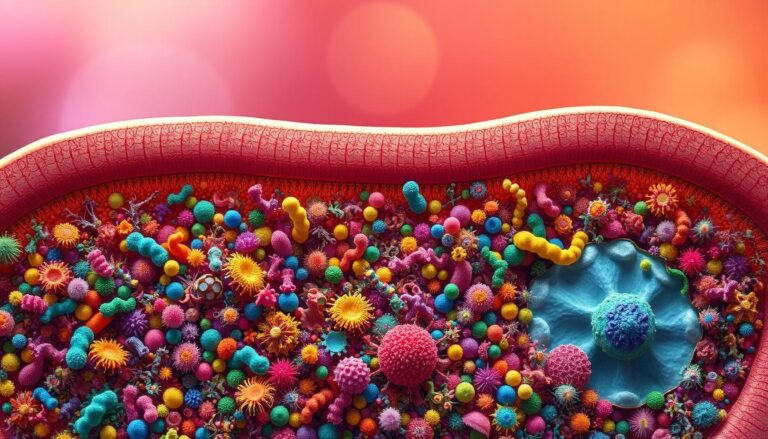Are you looking for a way to stay healthy, feel satiated and have the energy you need to conquer your day? Look no further! In this guide we will explore the world of high-fiber protein-rich foods and uncover the secrets to a balanced and nutritious diet.
From understanding the importance of these nutrients to discovering the best food sources, we will equip you with the knowledge to make informed choices and elevate your overall well-being.
So, are you ready to embark on a delicious and nourishing journey? Let’s dive in!
Key Takeaways:
- High-fiber and protein-rich foods are essential for a balanced diet.
- Incorporating these nutrients into your meals can provide numerous health benefits.
- Choosing the right protein and fiber sources is crucial for maximum nutrition.
- Meal planning plays a key role in maintaining a high-fiber, protein-packed diet.
- By embracing a balanced approach to eating, you can achieve long-term health benefits and sustainable lifestyle changes.
The Importance of Protein and Fiber in Your Diet
When it comes to eating a healthy and well balanced diet protein and fiber play crucial roles. These macronutrients are not only essential for various body functions but also contribute to overall optimal health.
Understanding their importance and incorporating them into your diet can have significant benefits for digestive health and overall well-being.
Understanding the Role of Protein in Body Functions
Protein is often referred to as the building block of life and for good reason. It is involved in numerous bodily functions including muscle growth repair, and maintenance. Consuming adequate amounts of protein is essential for supporting healthy organ function promoting a strong immune system, and regulating hormones.
Including sources of high quality protein, such as lean meats, poultry, fish, eggs, dairy products, and plant-based options like tofu and legumes can help ensure that your body gets the protein it needs.
How Fiber Contributes to Digestive Health
Fiber plays a vital role in maintaining digestive health. It acts as a natural cleanser, promoting regular bowel movements and preventing constipation. Fiber also helps regulate blood sugar levels and cholesterol levels, reducing the risk of heart disease and type 2 diabetes.
Additionally, high-fiber foods tend to be more filling, which can aid in weight management and prevent overeating. Including fiber-rich foods, such as fruits, vegetables, whole grains, legumes, and nuts, can help meet your daily fiber requirements and support a healthy digestive system.
Balancing Macronutrients for Optimal Health
While protein and fiber are important on their own, it’s crucial to strike a balance with other macronutrients, such as carbohydrates and fats, for optimal health. Achieving a well-rounded macronutrient balance ensures that your body receives all the necessary nutrients to function properly.
This balance not only supports energy production but also helps maintain stable blood sugar levels and promotes satiety. Including a variety of protein-rich foods, fiber-rich options, and healthy fats and carbohydrates in your meals can help you achieve this balance and maximize your overall health.

As you can see, protein and fiber are vital components of a nutritious diet. They contribute to various body functions, promote digestive health, and support overall optimal health.
By incorporating protein rich foods and fiber-rich options into your meals and balancing your macronutrient intake, you can take significant steps towards achieving an optimal state of well-being.
Picking the Right Proteins for Maximum Nutrition
When it comes to choosing proteins for maximum nutrition, there are a plethora of options available. Whether you follow a plant-based diet or include animal products in your meals, selecting protein sources that align with your nutritional needs is key.
Let’s explore different protein sources, their nutritional value, and some healthy options to help you make informed decisions.

- Eggs: A versatile protein source that is packed with essential amino acids, vitamins, and minerals.
- Chicken Breast: A lean protein option that provides high-quality protein with minimal fat content.
- Salmon: A fatty fish rich in omega-3 fatty acids, which are beneficial for heart health.
- Lean Beef: A great source of iron and vitamin B12, along with quality protein.
Plant-Based Protein Sources:
- Legumes: Including beans, lentils, and chickpeas, these provide a good amount of protein, fiber, and various nutrients.
- Tofu and Tempeh: Derived from soybeans, these options are excellent sources of plant-based protein.
- Quinoa: A complete protein that also offers fiber, iron, and magnesium.
- Nuts and Seeds: Such as almonds, walnuts, chia seeds, and flaxseeds, they add protein and healthy fats to your diet.
When choosing proteins, it’s important to consider their nutritional value. Look for options that are low in saturated fats, high in fiber, and contain essential vitamins and minerals. Incorporating a variety of protein sources into your diet ensures that you receive a balanced range of nutrients.
Remember the key to a healthy lifestyle lies in selecting protein sources that suit your dietary preferences and contribute to your overall well-being. Whether you opt for animal or plant-based options, prioritize nutrition and make choices that align with your health goals.
Fueling Your Body with Healthy Fiber Sources
When it comes to maintaining a healthy and balanced diet, incorporating fiber-rich foods is essential.
Fiber not only aids in digestion but also provides a range of health benefits. In this section, we will explore the best plant-based sources of fiber discuss how to incorporate fiber into every meal, and gain an understanding of the different types of fiber and their specific health benefits.
The Best Plant Based Sources of Fiber
If you’re following a plant-based diet or looking to add more fiber to your meals, there are plenty of delicious options to choose from. Some of the best plant-based sources of fiber include:
- Legumes Lentils, chickpeas, and black beans are packed with fiber, making them excellent additions to soups, stews, and salads.
- Whole Grains Incorporate whole grains like quinoa, oats, and brown rice into your meals for a fiber boost. These grains are not only rich in fiber but also provide important nutrients.
- Vegetables and Fruits Vegetables such as broccoli, Brussels sprouts, and avocados, along with fruits like berries and apples, are excellent sources of fiber. Aim to include a variety of colorful fruits and vegetables in your meals to maximize your fiber intake.
- Seeds and Nuts Chia seeds, flaxseeds, and almonds are fiber powerhouses that can be added to smoothies, yogurt, or enjoyed as a snack.
By incorporating these plant-based options into your meals, you can increase your fiber intake while enjoying a variety of flavorful and nutritious foods.
Incorporating Fiber into Every Meal
One of the key strategies for maximizing your fiber intake is to incorporate it into every meal. Here are some practical tips to help you achieve this:
- Start the day right Begin your day with a fiber-rich breakfast by incorporating whole grains, fruits, and seeds into your meal. Oatmeal topped with berries and a sprinkle of flaxseeds is a great option.
- Add vegetables to every meal Whether it’s a salad, stir-fry, or roasted vegetables, make it a habit to include a generous portion of vegetables in your meals. Not only are they high in fiber, but they also add color, flavor, and important nutrients.
- Choose whole grain options Opt for whole grain bread, pasta, and rice instead of their refined counterparts. These whole grain options are higher in fiber and provide a more sustained release of energy.
- Snack smart When it comes to snacking, reach for fiber-rich options like fresh fruits, nuts, or veggies with hummus. These snacks will keep you feeling satisfied and energized between meals.
By consciously adding fiber-rich foods to each meal and snack, you can ensure that you are fueling your body with the nutrients it needs for optimal health.
Understanding the Different Types of Fiber

| Type of Fiber | Benefits | Food Sources |
|---|---|---|
| Soluble Fiber | Helps lower cholesterol levels and regulates blood sugar levels | Oats, barley, legumes, citrus fruits |
| Insoluble Fiber | Aids in digestion and prevents constipation | Whole grains, nuts, seeds, vegetables |
| Resistant Starch | Acts as a prebiotic, promoting a healthy gut microbiome | Green bananas, cooked and cooled potatoes, lentils |
Understanding the different types of fiber can help you make informed choices when it comes to meal planning. By including a variety of fiber sources in your diet, you can reap the unique health benefits that each type offers.
Now that you know the best plant-based sources of fiber, how to incorporate fiber into every meal, and the different types of fiber, you can confidently fuel your body with healthy fiber sources and enjoy the multitude of health benefits they provide.
Combining Protein and Fiber for Satiating Meals
Incorporating a protein-fiber combination into your meals is key to creating satiating and satisfying dishes that are also nutritious and balanced. By combining these two essential nutrients, you can enjoy meals that keep you full for longer while providing the necessary nourishment your body needs.
One example of a protein-fiber combination is pairing lean chicken breast with steamed vegetables and quinoa. The chicken breast serves as a lean protein source while the vegetables and quinoa provide a good amount of dietary fiber.
This combination not only offers a variety of flavors and textures but also ensures a balanced meal that leaves you feeling satisfied.
Another option is a hearty salad with grilled salmon, leafy greens, chickpeas, and avocado.
This salad incorporates protein from the salmon and chickpeas while also delivering a fiber boost from the leafy greens and avocado. Adding a drizzle of olive oil and some lemon juice as a dressing can further enhance the taste and nutritional profile of the dish.
The key to creating satiating meals is to focus on combining protein and fiber to provide a balanced and filling experience while supporting overall health and well-being.
When designing your meals, consider including a variety of protein sources such as lean meats, poultry, fish, eggs, dairy, and plant-based alternatives like tofu, tempeh, and legumes. For fiber, incorporate whole grains fruits vegetables, and nuts into your dishes.
By incorporating protein and fiber in your meals, you can enjoy delicious, filling, and nutritious options that support your health and well-being. So get creative in the kitchen and experiment with different combinations to find the ones that satisfy your taste buds and keep you feeling full.

Nutritious Foods Rich in Fiber and Protein
When it comes to maintaining a healthy diet, incorporating nutritious foods that are rich in fiber and protein is essential.
These nutrient powerhouses not only provide numerous health benefits but also help keep you feeling satisfied and energized throughout the day. In this section, we will explore some of the top sources of fiber and protein, including legumes and beans, whole grains, and seeds and nuts.
Legumes and Beans A Powerhouse of Nutrition
Legumes and beans are a fantastic source of both fiber and protein. These plant-based wonders come in a variety of forms, such as lentils, chickpeas, black beans, and kidney beans. Incorporating legumes and beans into your meals can significantly boost your nutrient intake and support overall health.
Legumes and beans are not only packed with fiber and protein but also contain essential vitamins and minerals like iron zinc and folate. They are also low in fat and cholesterol-free making them an excellent choice for heart-healthy eating.
Whether you add them to soups, stews, salads, or even as the main ingredient in flavorful vegetarian dishes, legumes and beans make a delicious and nutritious addition to any meal.
Whole Grains that Offer Both Fiber and Protein
When it comes to incorporating both fiber and protein into your diet, whole grains are a fantastic option. Whole grains like quinoa, brown rice, oats, and farro not only provide a good amount of fiber but also contain plant-based proteins that are beneficial for overall health.
Whole grains are rich in complex carbohydrates, which provide long-lasting energy and help maintain stable blood sugar levels.
They are also packed with vitamins, minerals, and antioxidants that promote good health and reduce the risk of chronic diseases. Adding whole grains to your meals, such as using quinoa as a base for a protein-packed salad or enjoying a bowl of oatmeal topped with nuts and seeds, can help you meet your daily fiber and protein needs.
Seeds and Nuts for Snacking and Topping
Seeds and nuts are not only delicious but also offer a wide range of health benefits. They are excellent sources of fiber, protein, and healthy fats making them a perfect choice for snacking or topping your favorite dishes.
Seeds like chia seeds, flaxseeds, and pumpkin seeds are packed with fiber and provide essential omega-3 fatty acids. They can be added to smoothies, yogurts, or baked goods to increase their nutritional value.
Similarly, nuts such as almonds, walnuts, and pistachios are rich in both fiber and protein. They are also loaded with heart healthy fats vitamins, and minerals. Enjoying a handful of mixed nuts as a snack or using them as a topping for salads, oatmeal, or desserts can add a satisfying crunch and boost your fiber and protein intake.
By incorporating these nutritious foods rich in fiber and protein into your diet, you can ensure you are getting the essential nutrients your body needs for optimal health. Experiment with different recipes and combinations to create delicious and balanced meals that support your overall well-being.

| Nutritious Foods Rich in Fiber and Protein | Key Nutrients |
|---|---|
| Legumes and beans | Fiber, protein, iron, zinc, folate |
| Whole grains | Fiber, protein, complex carbohydrates, vitamins, minerals |
| Seeds and nuts | Fiber, protein, healthy fats, omega-3 fatty acids, vitamins, minerals |
Meal Planning Tips for a High Fiber Protein Packed Diet
Creating a meal plan that incorporates a high-fiber, protein-packed diet is key to achieving a balanced and nutritious eating routine. Let’s explore some tips and strategies to help you plan your meals effectively:
- Determine your daily macronutrient needs: Before you start meal planning, it’s important to understand your body’s protein and fiber requirements. Consult a nutritionist or use online calculators to estimate the optimal protein and fiber intake based on your age, gender, weight, and activity level.
- Include a variety of protein sources: Incorporate a mix of animal and plant-based protein sources in your meals. Lean meats, poultry, fish, eggs, tofu, legumes, and dairy products are great options to consider. This ensures that you’re getting a wide range of essential amino acids.
- Choose high-fiber foods: Include plenty of high-fiber options such as whole grains, fruits, vegetables, nuts, and seeds in your meal plan. These foods not only provide essential nutrients but also help promote satiety and support digestive health.
- Plan balanced meals: Aim to include a source of protein, fiber, and healthy fats in each meal. For example, pair grilled chicken with a side of roasted vegetables and quinoa, or enjoy a salad with mixed greens, grilled salmon, and a sprinkle of walnuts.
- Prep ingredients in advance: Spend some time prepping ingredients like marinated proteins, chopped vegetables, and cooked grains on your meal prep days. This will save you time during the week and make it easier to assemble balanced meals quickly.
- Experiment with recipes: Explore online resources, cookbooks, or apps to find new recipes that focus on high-fiber, protein-packed meals. This will keep your meals exciting and prevent repetition or boredom.
Meal planning is a flexible process, so don’t be afraid to modify your plan based on your preferences and schedule.
to listen to your body’s needs and make adjustments accordingly. By following these tips, you can create a meal plan that supports a high-fiber, protein-packed diet while enjoying a delicious variety of nourishing meals.

Conclusion
To truly achieve a healthy and nourishing diet, it is essential to embrace a balanced approach to eating. Incorporating high-fiber and protein-rich foods into your meals can have long-term benefits for your overall health and well-being. However, healthy eating should not be a one-time endeavor it should be a lifelong commitment.
By redefining your eating habits and making sustainable lifestyle changes, you can create a foundation for lasting health. This means focusing on whole, nutrient-dense foods that provide both fiber and protein. By choosing a variety of legumes and beans, whole grains, seeds, and nuts, you can ensure a well-rounded and satisfying diet.
Developing healthy habits is essential for maintaining a balanced approach to eating. Consider portion control, mindful eating, and listening to your body’s hunger and fullness cues. Don’t be afraid to experiment with new flavors and recipes as you embark on this journey towards better health.
Remember, a healthy lifestyle is not about deprivation or strict rules. It’s about finding joy in nourishing your body and making choices that support your long-term well-being. So, let’s bid farewell to fad diets and quick fixes and embrace a sustainable approach to eating that will bring us lifelong benefits.





